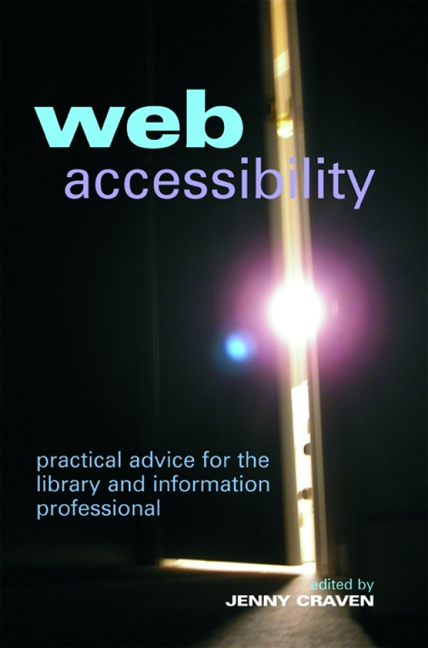Book contents
- Frontmatter
- Contents
- Contributors
- 1 Introduction
- 2 Tools used for widening access to the web
- 3 Design for All – how web accessibility affects different people
- 4 The importance of web accessibility
- 5 Accessibility advice and guidance
- 6 Accessibility evaluation and assessment
- 7 Issues for library and information services
- 8 Design for All in the library and information science curriculum
- 9 Best practice examples of web accessibility
- 10 Web accessibility in the future
- Index
10 - Web accessibility in the future
Published online by Cambridge University Press: 08 June 2018
- Frontmatter
- Contents
- Contributors
- 1 Introduction
- 2 Tools used for widening access to the web
- 3 Design for All – how web accessibility affects different people
- 4 The importance of web accessibility
- 5 Accessibility advice and guidance
- 6 Accessibility evaluation and assessment
- 7 Issues for library and information services
- 8 Design for All in the library and information science curriculum
- 9 Best practice examples of web accessibility
- 10 Web accessibility in the future
- Index
Summary
Introduction
This final chapter will take a critical look at some of the developments in web accessibility guidelines and assessment, and will provide some sug - gestions as to how these could be improved, in particular through a more holistic approach to web accessibility. It will then move on to consider accessibility issues surrounding the new emerging technologies and how these might relate to library and information services.
We have seen how the guidelines developed by the World Wide Web Consortium (W3C) Web Accessibility Initiative (WAI) have been widely accepted as an inter national standard for helping to ensure that web resources can be made widely accessible. But how successful has this approach proved in practice? And will the WAI guidelines continue to be relevant in a rapidly changing technical environment, in particular in a Web 2.0 environment with increasing use of technologies such as blogs and wikis, communication tools such as instant messaging and internet telephony applications such as Skype?
A critique of the WAI approach
WAI has been tremendously successful in raising awareness of the need for access to web resources for people with disabilities and in encouraging governments to enshrine such commitments in legislation, with WAI's Web Content Accessibility Guidelines (WCAG) having been widely adopted as best practice for use by web content providers (see Chapter 5, section on ‘The Web Accessibility Initiative Guidelines’).
However, even among individuals and groups who may be committed to web accessibility principles, there are growing criticisms regarding the approaches taken by WAI. Researchers and accessibility practitioners in the UK (including the author of this chapter) have been exploring these limit - ations, which include inconsistencies and ambiguities in the guidelines, the failure of the guidelines to reflect technological developments, and the diverse ways in which the web is now being used.
As described in a paper by Kelly et al. (2005), the approach developed by WAI is a simple model based on three components (illustrated in Figure 10.1): guidelines for web content (WCAG), guidelines for authoring tools (ATAG) and guidelines for user agents such as web browsers (UAAG). The assumption is that if authors follow the web content authoring guidelines using authoring tools that are based on ATAG and users make use of browsers that are based on UAAG then the resources will be universally accessible.
- Type
- Chapter
- Information
- Web AccessibilityPractical Advice for the Library and Information Professional, pp. 145 - 162Publisher: FacetPrint publication year: 2008

